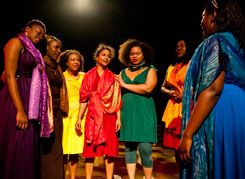Echoes of the Holocaust
A psychiatrist offers advice to physicians treating the aging survivors
By Bruce Morgan
Train stations, barking dogs, having to stand in line, uniforms, ovens, gas masks, German music, barbed wire, exhaust steam, shaving, showers, locks and doors, wristbands and flashlights—all these scattered details of modern life can be psychological triggers for Holocaust survivors, the objects, textures, patterns and sounds that plunge them back into nightmare. Michael Grodin supplied the list in a talk he gave to Tufts medical students earlier this month on “Caring for the Aging Holocaust Survivor.”

“This is difficult material, and it should be difficult,” said Michael Grodin at a School of Medicine talk. Photo: Alonso Nichols
“This is difficult material, and it should be difficult,” Grodin warned at the start of his presentation, before providing a rapid-fire survey of the history of the rise of anti-Semitism in Europe and its grim legacy. Grodin, a psychiatrist, directs the Project on Medicine and the Holocaust at the Elie Wiesel Center for Judaic Studies at Boston University. He has been studying the Holocaust for 32 years, with a special interest in the resilience of the human spirit. He has spoken widely and edited or co-edited five books on the subject, including The Nazi Doctors and the Nuremberg Code and Children as Research Subjects.
Doctors were deeply involved in the extermination program that by the end had killed two out of every three European Jews, he said. “Fifty percent of German doctors were members of the Nazi Party. Hitler was fighting two wars—one against the countries he conquered and one against the Jews,” Grodin said. “Physicians were involved in all aspects of this second campaign.” At its height, as many as 20,000 to 30,000 people were being murdered a day. “Imagine the logistics of that,” Grodin said quietly.
Holocaust survivors who are still alive—an estimated 750,000 people around the world—were mostly children during World War II and are elderly today. “We are seeing the first group of genocide survivors who have lived to old age,” he noted.
Their medical needs are overwhelming. Half of them live in poverty. They commonly suffer from depression, amnesia, anxiety, anger, sleep disturbances and survivor’s guilt. Their levels of post-traumatic stress disorder (PTSD) are dramatically elevated, Grodin reported. Compared with about 5 percent of the general population, between 39 and 65 percent of Holocaust survivors show the effects of PTSD. In addition, they suffer from what Grodin termed “complex PTSD,” reserved for victims of prolonged physical abuse who were also trapped and powerless to escape.
For the survivors, walking out of the camps and reentering modern life after the war proved problematic at best. A “conspiracy of silence” in the post-war period didn’t help, Grodin said. More recently, efforts to get survivors to break their silence and begin talking about their experiences have found limited success. In his therapeutic role, Grodin counsels survivors about seven hours each week. The memories never go away. “We have nursing home residents who smell a certain smell and think they’re back in the camps,” he said.
Grodin noted that a doctor once asked Elie Wiesel, H86, the Romanian Jew who survived internment at Auschwitz as a teenager and went on to write extensively about the Holocaust in works such as Night and The Town Beyond the Wall, how he would recommend treating Holocaust survivors. “Listen to them carefully,” Wiesel replied. “They have more to teach you than you do them.”
The suffering of the camps has echoed from one generation to the next. Survivors’ children, who number about 250,000 in the United States alone, have felt the effects of the Holocaust, too. Matched with the “complicated mourning” that prevailed among survivors—the guilt of being alive when so many others around them perished—was the children’s collective desire to excel and be “perfect” sons and daughters in hopes of relieving their parents’ pain. “Many children of survivors went into medicine and the caring professions,” Grodin pointed out. “It’s a kind of repair.”
Bruce Morgan can be reached at bruce.morgan@tufts.edu.


